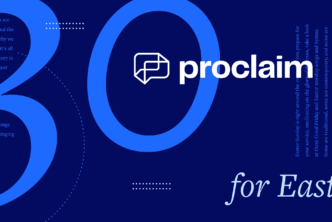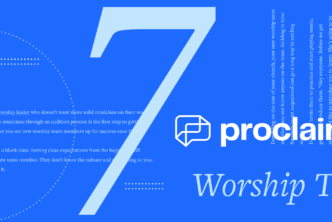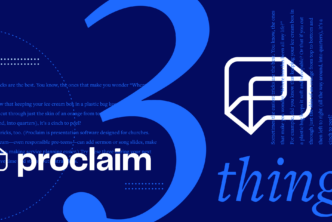Today’s guest post is by Susan Fontaine Godwin, founder and president of Christian Copyright Solutions—a leading authority on church-music copyrights. She is frequently featured in Christian magazines, where she equips teams and churches to honor copyright law and use the best materials available for their worship.
Most churches want to do the right thing and honor copyrights, but in the face of complicated copyright laws, it’s a very intimidating prospect. When I visit churches and teach about copyright issues, pastors and leaders often say they feel overwhelmed and confused. It’s just hard to know where to begin.
In order to promote copyright compliance, church leaders need to establish a firm foundation based on three basic building blocks:
1. What is a copyright?
Copyright literally means the right to copy. The term has come to represent the body of exclusive rights granted by statute to authors to protect their writing. It includes the exclusive right to make and publish copies of the copyrighted work, to create other versions of the work, and with certain limitations, to record the work or perform it in public. It’s their intellectual property.
Intellectual property refers to intangible properties that are protected under the US copyright, patent, and trademark laws—article I, section 8, clause 8 of the US Constitution. Although it is an intangible property, or intellectual property, a copyright is a particular kind of property right.
The novels or songs that you purchase (hopefully) and download onto your iPad are copyrights or intellectual properties, and they are owned by someone, unless they are in the public domain. Even when they are intangible assets that cannot be touched, the owners of the works have the exclusive right to reproduce or make copies of them, or to authorize a third party to do so.
For example, the author of a song or composition, from the time of the song’s creation, has the exclusive right to reproduce, adapt, display, distribute, or perform that song. The author’s exclusive rights are valuable, and they can be assigned to a third party, such as a publisher, if the assignment is documented and signed.
The rights described in our United States Copyright Act derive from the United States Constitution, which in article I, section 8, clause 8, grants our citizens special protection: “to promote the progress of science and useful arts, by securing for limited times to authors and inventors the exclusive right to their respective writings and discoveries.” Consequently, those who create “original works of authorship fixed in any tangible medium of expression,” according to the Copyright Act title 17 [section 102], have created works subject to copyright protection.
2. What can be copyrighted?
Only certain works are eligible for copyright protection. Section 102 of the Copyright Act defines copyrightable “works of authorship” to include the following eight works:
Music
“Music” includes accompanying words, lyrics, notes, and composition in a published format. Musical works include original compositions and original arrangements, as well as new versions of earlier compositions to which new copyrightable authorship has been added. For example, “Amazing Grace” is in the public domain, but Chris Tomlin and Louie Giglio added a chorus for “Amazing Grace (My Chains Are Gone),” so it is considered a new, copyrightable addition.
Sound recordings
“Sound recordings” include aural reproduction of some material, which may or may not be copyrighted itself. They are works that result from the fixation of a series of musical, spoken, or other sounds, but not including the sounds accompanying a motion picture or other audiovisual work. They may include recordings of music, literary works, drama, etc. For example, Michael W. Smith’s recording of Paul Baloche’s “Open the Eyes of My Heart” is a sound recording copyright and the actual composition or song is a music copyright. In this case, the sound recording is owned and copyrighted by a record label, and the music is owned and copyrighted by a different publishing company.
Visual arts
“Visual arts” include pictorial, graphic, or sculptural works, two-dimensional and three-dimensional works of fine, graphic, and applied art. For example, photos, maps, illustrations, cartoons, sculptures, paintings, and other visual images would all be visual arts.
Literary works
“Literary works” include words captured as a book, periodical, poem, essay, spoken work (e.g. speeches), etc., as well as nondramatic textual works with or without illustrations. Computer programs and databases are also considered literary works. Plays, dramas, and screenplays are not in the literary works category.
Video / films
This includes a series of related visual images that impart an impression of motion. The work or may not be accompanied by sound, such as films, videos, slide presentations, and video games.
Choreography, dance, and pantomime
Choreography is the composition and arrangement of dance movements and patterns, usually intended to be accompanied by music. Distinct from choreography, pantomime is the art of imitating or acting out situations, characters, or other events.
Drama
In copyright terms, “drama” is considered to be the play itself. This includes dialog, stage direction, etc., and it can include the musical score. Individual musical numbers may also be copyrighted as a music copyright. Dramatic works such as plays, screenplays, and radio or television scripts are works intended to be performed. Dramatic works usually include spoken text, plot, and directions for action.
Architecture
“Architecture” includes original design of a building embodied in any tangible medium of expression, including a building, architectural plans, or drawings.
Copyright protection for an original work of authorship does not extend to any idea, procedure, process, system, method of operation, concept, principle, or discovery. This means that if you have an idea for a song, the idea itself cannot be copyrighted. The moment you begin composing the song though, it is a copyrightable work.
It’s vital for church leaders to know all the types of works that can be copyrighted because of the increasing use of a variety of creative works and the growing risk of liabilities. Copyright infringement penalties can be severe—up to $150,000 for each infringement! Fifteen years ago, churches primarily reproduced and used music (only one of the eight copyrightable works), but today churches are creatively using just about every type of work listed above.
3. What are the rights of copyright owners?
To understand copyright law and how it impacts your ministry, you need to understand the six rights that are exclusive to the owner of a given copyrighted work. These rights apply to all works that can be copyrighted. If you want to engage in any of the activities that are the exclusive right of a work’s owner (such as performing, reproducing, or using that work), you need to get permission to engage in that activity.
Reproduction
Only the owner of a copyrighted work is allowed to reproduce or copy that work.
Examples include photocopying lyrics, making rehearsal CDs, or creating a copy of a video.
Making derivative works
Only the owner of a copyrighted work is allowed to create new works that are “based” on a preexisting work. US copyright law describes a derivative work as “. . . a work based upon one or more preexisting works, such as a translation, musical arrangement, dramatization, fictionalization, motion picture version, sound recording, art reproduction, abridgment, condensation, or any other form in which a work may be recast, transformed, or adapted.”
Examples include arrangements of songs or adaptations of plays into movies.
Distribution
Only the owner of a work can make that work available to the public by sale, rental, lease, lending, or gifting. However, the “first sale” doctrine limits an owner’s control to the “first sale” of a copy. This means that if you buy a CD, you are allowed to resell that CD without permission from the work’s owner.
Examples include distributing CDs of worship services or podcasts of worship services.
Performance
The owner of a work controls if and when that work will be performed publicly. US copyright law defines a public performance as an instance of music being performed “in a place open to the public or at any place where a substantial number of persons outside of a normal circle of a family and its social acquaintances is gathered.” This could include your church service. Churches are allowed to play or perform music in a religious service in a place of worship, but music played or performed outside of the service requires a license. Public performances extend to more than just in-person performances. Music played on TV, radio, and the Internet is also under the control of the work’s owner.
Examples include concerts, music played at church social events, on-hold music, exercises classes, fundraisers, coffee shops, wedding receptions, or VBS.
Public display
The owner of a work controls if and when that work will be displayed publicly. This right is similar to the performance right, but it pertains to visual works such as photos or videos. The criteria for a public display are the same as those for public performances detailed above.
Examples include hanging art in a church lobby or displaying a photograph on screens during worship services.
Digital recording performance
The owner of a sound recording controls if and when that work will be transmitted digitally. This is a relatively new right that was added in The Digital Performance Right in Sound Recordings Act of 1995.
If a church wants the right to reproduce, perform, distribute, display, or make a derivative of a work that falls under one of the eight types of copyrights, then that church must obtain permission or a license for the specific rights you need. Whether a blanket license or an individual license, the agreement will specify what rights are included for the specific use.
The US Copyright Law provides for some exceptions and exemptions, such as the Religious Service Exemption, that may allow people to use copyrighted works without obtaining permission. Churches may want to obtain legal counsel from a copyright attorney regarding what exemptions could apply to their activities.
***
Proclaim automatically connects your presentations to your CCLI SongSelect account, so you can quickly assemble your presentations with songs that honor God and the artists that wrote them. Save time without ever violating copyright law, and put together beautiful services easier than ever. Download Proclaim today to try it free.




